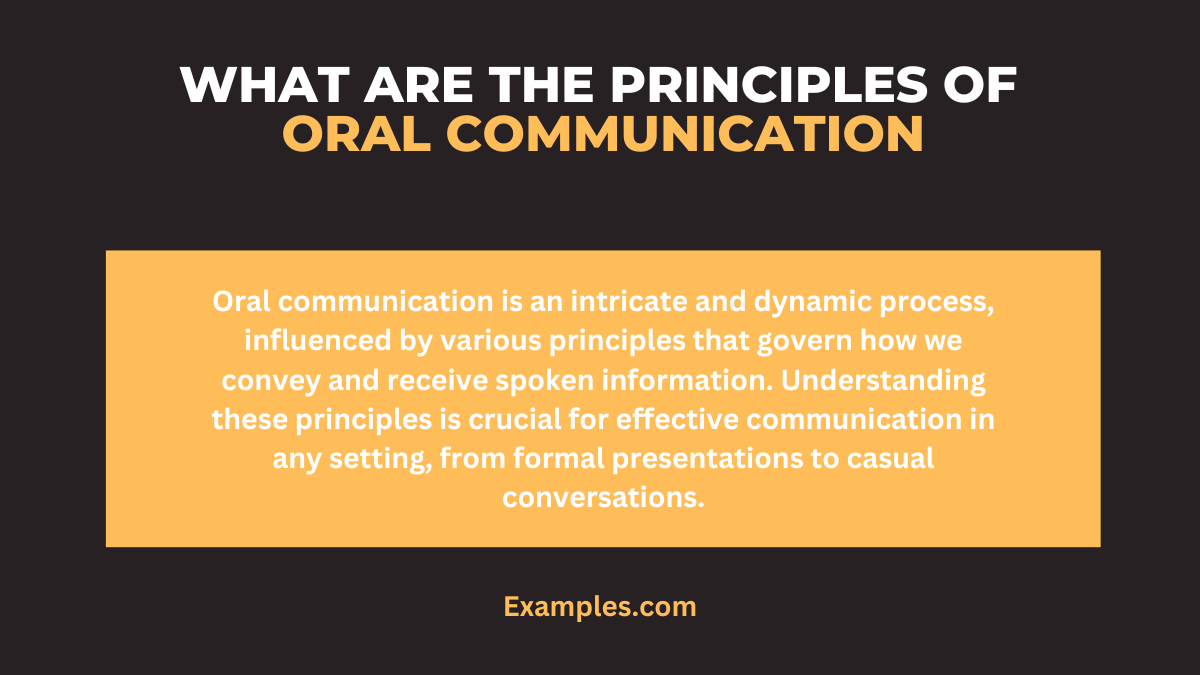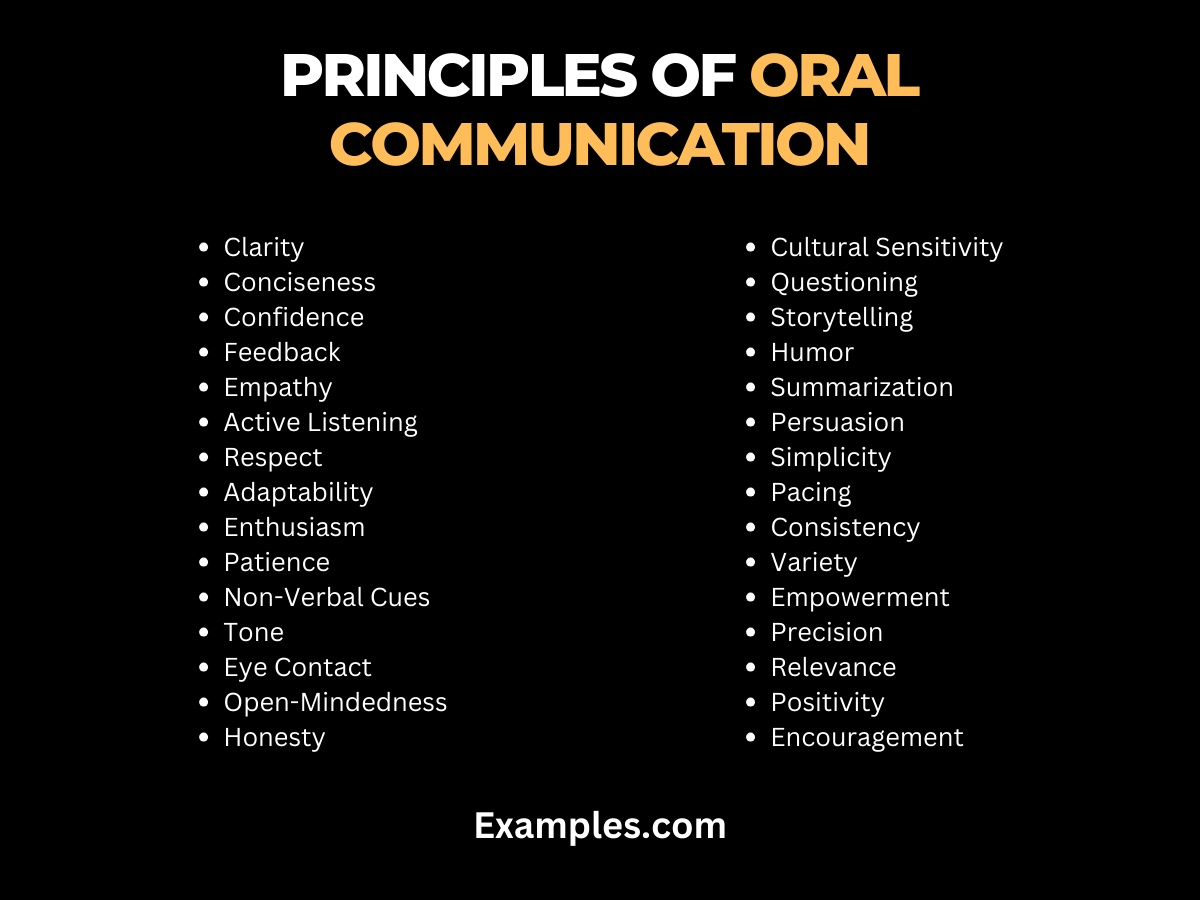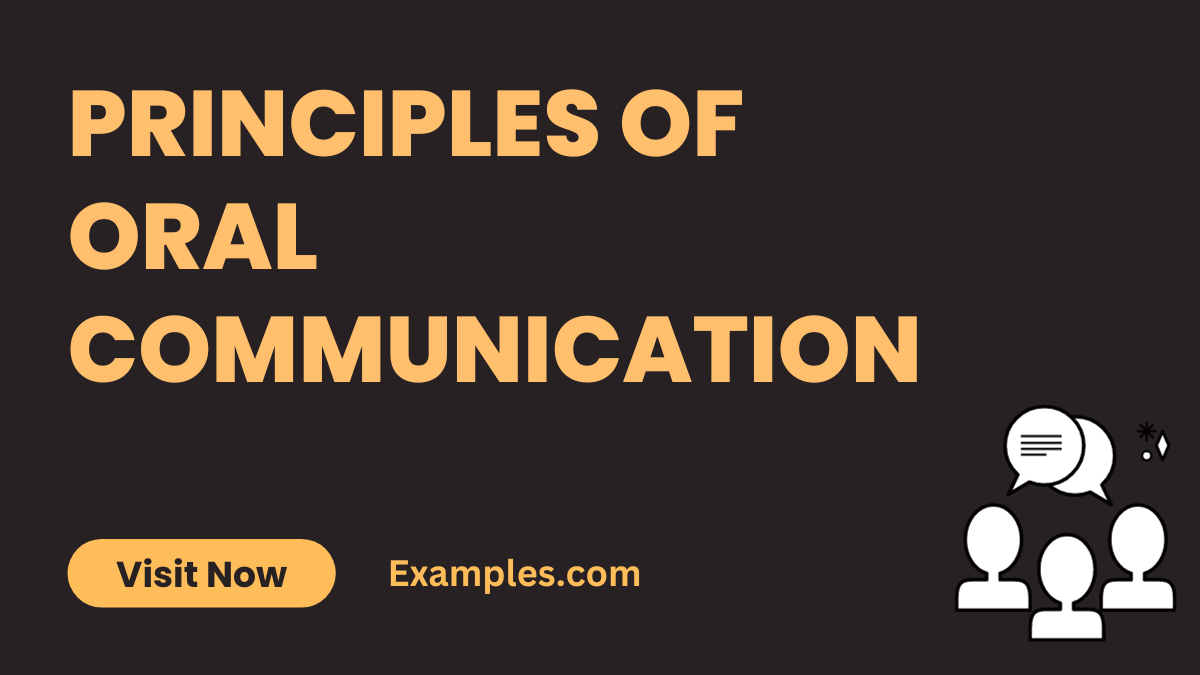29+ Principles of Oral Communication Examples
Oral communication is an essential skill in both personal and professional settings. This comprehensive guide delves into the fundamental principles of oral communication, providing practical advice and communication examples to enhance your speaking abilities. Whether you’re a student aiming to improve your presentations or a professional looking to sharpen your interpersonal skills, this guide offers valuable insights into speaking with clarity and confidence. Understand the nuances of effective communication and how to apply these principles in various scenarios.
What are the Principles of Oral Communication?

Oral communication is an intricate and dynamic process, influenced by various principles that govern how we convey and receive spoken information. Understanding these principles is crucial for effective communication in any setting, from formal presentations to casual conversations.
30 Principles of Oral Communication

Oral communication is more than just talking; it’s an art that combines multiple principles for effective and impactful exchanges. From active listening to empathy, each principle plays a crucial role in enhancing our communication skills. This section explores 30 key principles, each accompanied by a distinct and illustrative example, demonstrating how to apply these principles in real-life scenarios.
- Clarity: Ensure your message is clear and easily understood.
Example: “I need the report by 5 PM today, with all the statistical analysis included.” - Conciseness: Be brief and to the point.
Example: “Please email me the summary by noon.” - Confidence: Speak with assurance and conviction.
Example: “I am certain our strategy will increase our market share.” - Feedback: Encourage and utilize responses for effective communication.
Example: “Could you please give me your thoughts on this proposal?” - Empathy: Understand and acknowledge your audience’s feelings.
Example: “I realize this is a challenging time for you, and I’m here to help.” - Active Listening: Listen attentively and respond appropriately.
Example: “I understand you’re concerned about the deadline; let’s discuss how we can address this.” - Respect: Value the opinions and perspectives of others.
Example: “I appreciate your viewpoint on this matter.” - Adaptability: Adjust your communication style based on your audience.
Example: “For our younger audience, let’s use more visuals and interactive content.” - Enthusiasm: Show genuine interest and excitement.
Example: “I’m really excited about the potential of this project!” - Patience: Be patient in allowing others to express themselves.
Example: “Take your time to explain; I’m here to listen.” - Non-Verbal Cues: Use body language to reinforce your message.
Example: Nodding while saying, “I completely agree with your point.” - Tone: Adjust your tone to suit the message and audience.
Example: Using a gentle tone when offering constructive feedback. - Eye Contact: Maintain eye contact to engage with your audience.
Example: Looking at your team members as you speak in a meeting. - Open-Mindedness: Be receptive to new ideas and perspectives.
Example: “That’s an interesting approach; tell me more about it.” - Honesty: Be truthful in your communication.
Example: “Honestly, we’re facing some challenges with this project.” - Cultural Sensitivity: Respect and adapt to cultural differences.
Example: “I understand this topic has different connotations in your culture.” - Questioning: Ask questions to clarify and engage.
Example: “What do you think led to the success of this campaign?” - Storytelling: Use stories to make your message more relatable.
Example: “Let me tell you about a customer who faced a similar issue…”

- Humor: Appropriately use humor to lighten the mood.
Example: “As they say, all’s well that ends well, right?” - Summarization: Summarize key points to reinforce the message.
Example: “So to summarize, our three main goals are…” - Persuasion: Persuade effectively without being pushy.
Example: “Imagine the benefits we’ll gain from implementing this strategy.” - Simplicity: Keep your language simple and accessible.
Example: “In other words, it’s like flipping a switch.” - Pacing: Control the speed of your speech for clarity.
Example: Speaking slowly and clearly when explaining complex concepts. - Consistency: Be consistent in your messaging.
Example: “As I mentioned last week, our focus remains on quality.” - Variety: Vary your voice to maintain interest.
Example: Changing your tone to emphasize important points. - Empowerment: Communicate in ways that empower others.
Example: “Your input is valuable and can make a real difference.” - Precision: Be precise in the information you convey.
Example: “The exact figure is 42.7% as per the latest data.” - Relevance: Keep your communication relevant to the topic.
Example: “Let’s stay focused on the current quarter’s targets.” - Positivity: Maintain a positive attitude in your interactions.
Example: “Despite the challenges, I’m confident we can succeed.” - Encouragement: Encourage others through your words.
Example: “I’ve seen your work; you’re definitely capable of handling this project.”

Each principle, with its corresponding example, serves as a guide to enhancing our oral communication skills, making our interactions more effective, meaningful, and impactful.
What are the Principles of Effective Oral Communication?
Effective oral communication is pivotal in brand communication, where conveying a clear and compelling message can significantly impact brand perception. Here, we outline ten principles essential for mastering this skill:
- Clear Messaging: In brand communication, it’s crucial to convey your message with clarity. This ensures that your brand’s values and propositions are understood without ambiguity.
- Consistent Brand Voice: Maintaining a consistent voice across all communication channels reinforces your brand identity and aids in building trust with your audience.
- Audience Awareness: Understanding your audience’s preferences and needs allows for tailored messages that resonate more effectively.
- Feedback Integration: Actively seeking and integrating feedback demonstrates a brand’s commitment to its audience and can enhance communication strategies.
- Adaptability: The ability to adapt messaging to different platforms and contexts is key in reaching a broader audience.
- Storytelling: Utilizing storytelling in brand communication creates an emotional connection with the audience, making the brand more relatable and memorable.
- Transparency: Honesty and transparency in communication foster trust and credibility for the brand.
- Engagement: Engaging with the audience through interactive content or dialogues can build a stronger community around the brand.
- Visual Elements: Incorporating visual elements can enhance the impact of oral communication, making it more engaging and memorable.
- Continual Learning: Staying informed about communication trends and continuously refining strategies are vital for keeping the brand relevant and engaging.
Principles of Successful Oral Communication
Successful oral communication, particularly in the context of brand communication, requires a strategic approach. Here are ten principles that can lead to more impactful interactions:
- Emotional Connection: Creating an emotional bond with the audience can make your brand’s message more impactful and memorable.
- Clarity and Brevity: Delivering a clear, concise message helps in retaining the audience’s attention and ensuring comprehension.
- Audience Engagement: Engaging the audience through questions or interactive elements makes the communication more dynamic and inclusive.
- Positive Messaging: Using positive language in communication can influence the audience’s perception and attitude towards the brand.
- Cultural Sensitivity: Being sensitive to cultural nuances ensures that the message is respectful and appropriate for diverse audiences.
- Authenticity: Authentic communication helps in establishing a genuine connection with the audience and builds brand loyalty.
- Persuasion Skills: Effectively persuading the audience about the value of the brand or product is key to successful communication.
- Active Listening: Demonstrating active listening shows respect for the audience and can provide insights for future communication strategies.
- Consistency: Consistent messaging across all platforms solidifies the brand’s identity and message.
- Feedback Loop: Establishing a feedback loop with the audience helps in making informed decisions and improving communication strategies.
Mastering the principles of oral communication is vital for effective brand communication. By focusing on clarity, audience engagement, storytelling, and continual adaptation, brands can forge stronger connections with their audiences. These principles, when skillfully applied, can elevate a brand’s message, making it more persuasive, memorable, and impactful.
Ultimately, mastering oral communication is a lifelong journey, continually evolving with personal and professional growth. As technology reshapes the way we interact, staying informed about new communication strategies becomes crucial. Websites like TED Talks offer valuable insights into contemporary communication techniques, helping individuals adapt to changing dynamics (TED Talks: The Art of Communicative Leadership). Embracing these principles not only enhances our ability to convey messages effectively but also empowers us to build stronger, more meaningful connections in every aspect of our lives.



